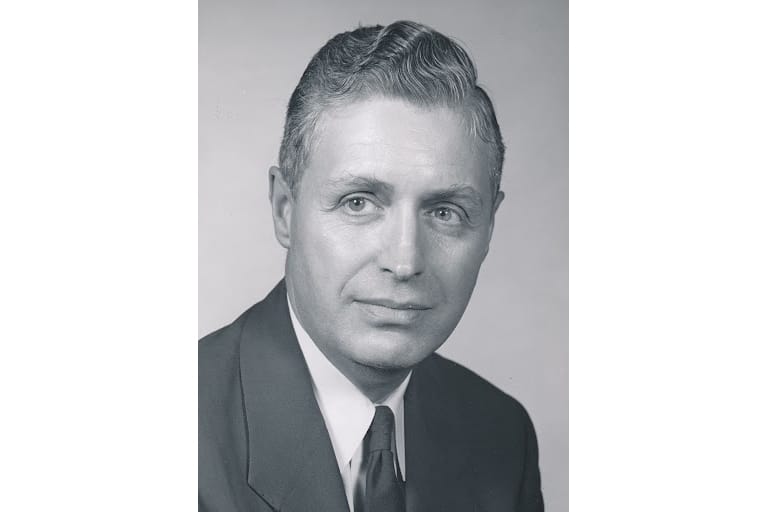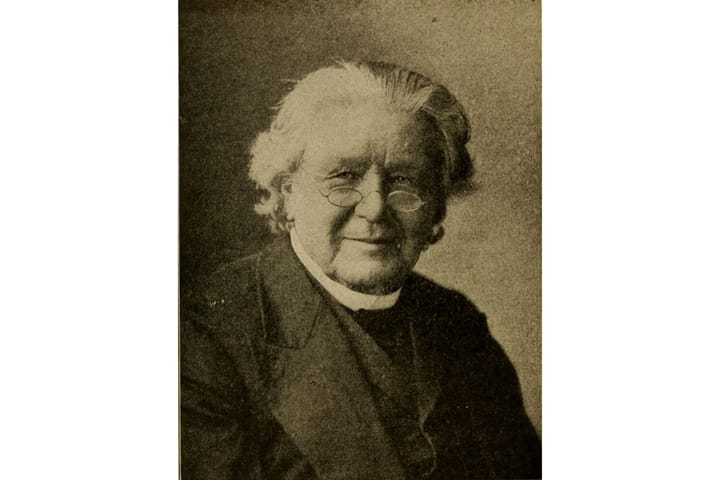Local Legends: An aptitude for excellence
John D. Millett, Miami University's 16th president and the namesake of Millett Hall, brought military and planning experience to the role.

John D. Millett was a man of many talents and showed an aptitude for excellence throughout his long academic career.
Born on March 14, 1912 in Indianapolis, Indiana, Millett was the son of Grover Allen Millett and Helen Elizabeth (Welch) Millett. His father worked as a bookkeeper for a local retail store and was later the president of a clothing store.
Millett grew up in Indianapolis and attended Stockridge High School. The school’s yearbook from 1929 said of Millett, “John is one of the most outstanding members of our class, both in the classroom and out” before going on to describe his involvement with the school’s debate team, fiction club, student council, National Honor Society and annual staff and his winning of an oratorical contest.
After high school, he completed his undergraduate and met his future wife Catherine (Letsinger) Millett at DePauw University. Millett followed her to Columbia University, where he completed his Master’s and Doctorate.
The couple was married on Sept. 2, 1934. They raised three sons, Allan R. Millett, Stephen M. Millett, and David P. Millett.
Millett stayed on with Columbia University, joining their faculty as a professor of government and public administration. In this role, he served on several commissions and conducted research, including traveling to England in the late 1930s to study British unemployment.
Millett took on the Great Depression through his service on the National Resource Planning Board, a New Deal agency created to serve as a planning board for public works projects. He also served on the President's Committee on Administrative Management, or the Brownlow Committee, which sought to reorganize the executive branch of the federal government.
With the onset of World War II, Millett left Columbia to join the U.S. Army. He served on the staff of General Brehon B. Somervell, commander of U.S. Army Service Forces notable for overseeing the construction of the Pentagon, the building in which Millett would work while in the service. Millett, who achieved the rank of colonel, described General Somervell as, “impatient, tense, and decisive“ in the official World War II history of Army Service Forces that he later wrote for the Center of Military History in 1954.
Millett remained in the Army until 1947 and after his discharge returned to Columbia and served on the Commission on Organization of the Executive Branch of the Government, known as the Hoover Commission. The Hoover Commission, appointed by President Harry S. Truman, sought to reorganize the Federal Government in the Post-War period.
After a period of service as the executive director of the Commission on Financing Higher Education, Millett was recruited to serve as the 16th president of Miami University by the school’s Board of Trustees. Millett, who took over following the death of President Ernest H. Hahne, remained in that position from 1953 until 1964, a total of 11 years.
Millett brought his experience and expertise with him into his new role and quickly set about making changes. One of the first was the adoption of a common curriculum for all undergraduate students to study as part of their degree programs. This is now known as the Miami Plan.
Another issue that Millett had to work out was the growth of the university. With the Baby Boomer generation entering higher educational institutions, Millett chose to create a more selective admission process rather than accepting every Ohio applicant, as had previously been the case.
Millett also saw the value in expanding, especially in expanding branch campuses, the trend in higher education in the 1960s. Millett initiated the creation of the Middletown and Hamilton Campuses of Miami in 1966 and 1968, respectively.
Additionally, enrollment increased by almost 9,000 students during his tenure, rising to a total of 15,000, 5,000 of whom attended Hamilton and Middletown campuses. He constructed 29 new buildings for the university, including the Sesquicentennial Chapel, built in 1959 in commemoration of 150 years since the university’s 1809 charter.
Working with Ohio State University, Millett also saw to the establishment of a joint branch campus in Fairborn, Ohio in 1964. This branch campus evolved into a separate university in 1965 and in 1967 was renamed Wright State University.
The Ohio Board of Regents was created in 1963 to coordinate policies, manage funding for, and strategically consider the role of the state’s public colleges and universities. Millett was named the first chancellor of the agency, which is now called the Ohio Department of Higher Education, and left Miami to serve in that role.
He remained the chancellor until 1972 when he returned to Washington as a senior vice president for the Academy for Educational Development. Millett semi-retired in 1980 and came back to Oxford, where he worked as a part-time professor of educational leadership and adjunct professor of political science at Miami for the next four years.
Millett published his twentieth, and final, book in 1984, four years before suffering a near fatal heart attack. He and his wife relocated to a Cincinnati retirement home where he died on Nov. 14, 1993 at the age of 81. Catherine survived until age 94, dying on Jul. 10, 2008. They were both buried in Oxford Cemetery.
Brad Spurlock is the manager of the Smith Library of Regional History and Cummins Local History Room, Lane Libraries. A certified archivist, Brad has over a decade of experience working with local history, maintaining archival collections and collaborating on community history projects.




